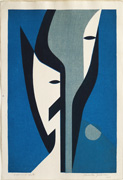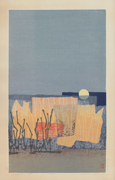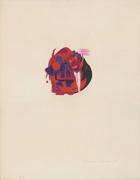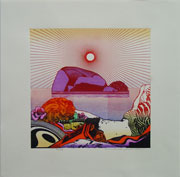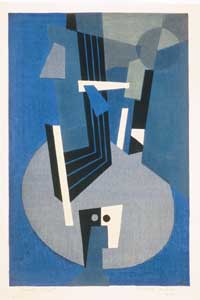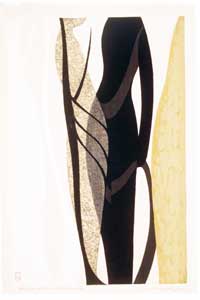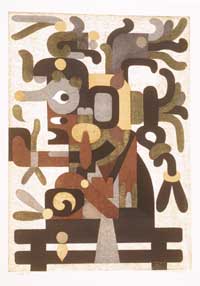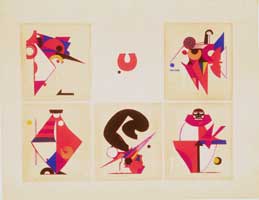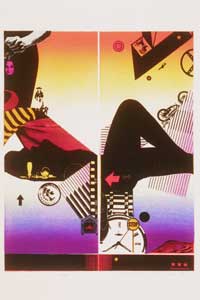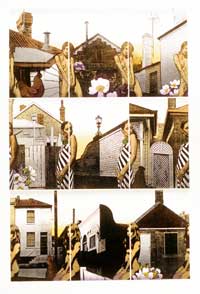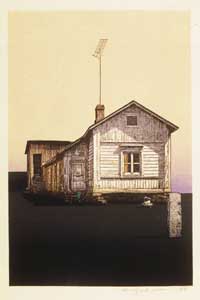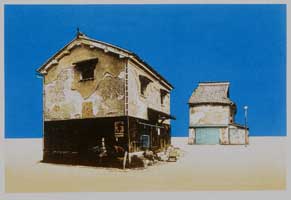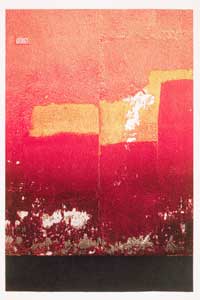Prints in Collection
Love and Hate, 1951
IHL Cat. #1053
森 (Woods), 1955
IHL Cat. #1247
Beast, 1960
IHL Cat. #263Yosooi - Girl, 1964
IHL Cat. #240
Tōi sato (Distant Home), 1968
IHL Cat. #1268
Biography
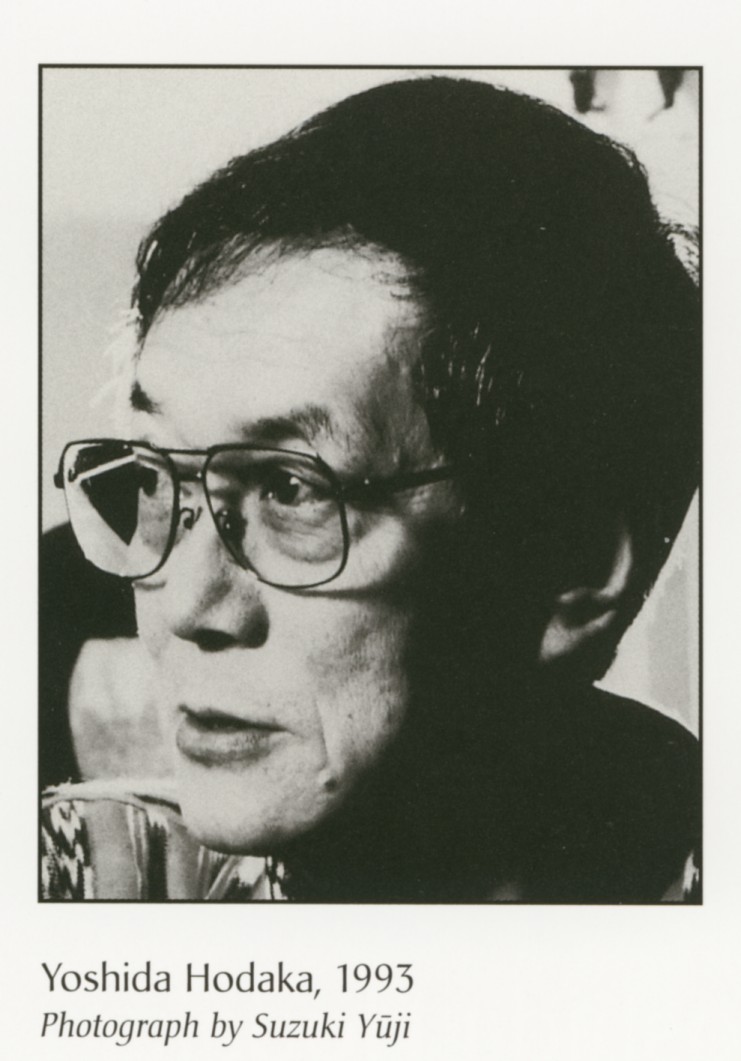 | Sources: "Magic, Artifact, and Art," Eugene M. Skibbe, appearing in A Japanese Legacy: Four Generations of Yoshida Family Artists, LauraW. Allen, Kendall H. Brown, Eugene M. Skibbe, et. al., The MinneapolisInstitute of Arts, 2002; website of Eugene and Margaret Skibbe's collection of the prints of Hodaka Yoshida http://www.hodakayoshidaprints.com; http://en.wikipedia.org/wiki/Hodaka_Yoshida; Guide to Modern Japanese Woodblock Prints:1900 – 1975, Helen Merritt and Nanako Yamada, University of Hawaii Press, 1992, p. 171.Early YearsBorn 1926 in Tokyo, Hodaka is the second son of the celebrated print artists Yoshida Hiroshi (1876-1950) and Yoshida Fujio (1887-1987). He attended Daiichi High School, considered the best high school in Japan at the time. Although showing an early interest in art, he was encouraged instead to study science. In the aftermath of World War II, with Japanese society undergoing rapid change and new freedoms abounding he followed his own passion, and with the complicity and encouragement of his older brother, the artist Yoshida Toshi (1911-1995), began experimenting with abstract oil painting. |
With government control over art ending, and new non-traditional avenues for artists opening up, Hodaka, even as a novice artist, was able to show his work. He exhibited his early oils in the Second Nihon Indepéndent exhibition in 1948 and then in the First Yomiuri Indepéndent in 1949. These venues provided immediate publicity for his oil paintings which were positively received.
Woodblock Prints
Hodaka began experimenting with woodblock prints in 1949, and in 1951 he exhibited his woodblock prints and oil paintings together. In 1952 Hodaka exhibited prints at the Japan Print Association’s (Hanga Kyokai) annual show and again received an encouraging response.
In 1953, Hodaka and his fiancée, the artist Chizuko Inoue married and built a house in the family compound. He and Chizuko joined the Abstract Art Club that year and Hodaka increasingly focused on his woodblock prints, creating 36 prints during that year.
Hodaka began to create exhibitions of his own work and then expanded his showings to the international art biennials. He also showed in almost all of the College Women’s Association of Japan (CWAJ) annual print shows. These venues allowed Hodaka creative freedom and he was continually on the cutting edge in using new print technologies.
As with all the Yoshida family artists, Hodaka frequently traveled abroad. While he traveled to many countries, he was most heavily influenced by indiginous cultures and their artifacts.
Looked at within his own specific art historical context, Hodaka is a good example of a Japanese artist who remained independent, while being fully engaged in the international art world and its clientele.
Stages of Artistic Development
Instead of having a straight line development, Hodaka's work moved forward in a series of stages. For example, his 1955 encounter in Mexico with primitive Pre-Columbian artifacts and architecture radically reoriented his art. A survey of the total range of his work - about 600 prints over 45 years - reveals distinct periods, each having major changes in subject matter, vocabulary, style, and color pallet. His styles, while always his own, drew from Expressionism, Pop, Photorealism, and Color Field abstraction. Broadly speaking most of his prints would be categorized as sosaku hanga.
As identified by Eugene Skibbe, Hodaka Yoshida collector and scholar, Hodaka's work can be broken into nine stages (six major and three transitional) which structured Hodaka’s 45 year career. He states: "Each stage has its own vocabulary, color palette, and style."
1950-53 Early Prints - semi-abstract visual essays reflecting on an object or people in emotional states with little or no reference to spatial depth or perspective. [See the print Love and Hate, IHL Cat. #1053.]
1953-54 Buddhist Prints - modern reformulations of Buddhist sculpture and architecture in a variety of artistic styles, e.g. abstract to realistic
1955-63 Primitive Energy Prints - abstractions of the primitive in Pre-Columbian forms achieving a feeling of motion
1963-66 Folk Prints (Transition A) - primitive abstractions expressed in an entirely new way reflecting the tumultuous times and influenced by New York's Pop art scene
1966-74 Mythology and Landscape Prints - Pop art exposé of modern culture in decline using mass-media images with employing collage
1974-79 House and Nude Prints (Transition B) - images displaying the tension and paradox between the old and modern with continued use of collage in many prints
1979-84 From My Collection Prints - a refinement of his previous transitional phase using his photographs as primary elements
1984-91 Recollection Prints (Transition C) - continued use of photographs showing old and distressed objects, giving prominence to color
1991-95 Wall Prints - the human story on the surfaces of old walls which paralleled his published poetry
Examples of Hodaka's Stages in Artistic Development
Source: Eugene Skibbe's website http://www.hodakayoshidaprints.com/
woodblock
Early Period
woodblock
Buddhist PeriodCrafty God, 1956
woodblock
Primitive Energy Period
Use of Varied Printing Techniques
Leadership Role
Hodaka became a leader among Japanese print artists. He was a member of the Nihon Hanga Kyokai (Japan Print Association) from 1952 and, in 1978, he became a committee member in the Japan Artists' Association and later a representative to the International Artists' Association and one of its vice presidents. On behalf of the Japan Print Association, he oversaw the enormous task of researching and organizing its "25 Years of World Exhibitions of Modern Print Art," which was held in 1981 in Tokyo. He exhibited at the Tokyo Biennale, Lugano, Ljubljana, Krakow, Frechen, Ibiza, and others. He received eleven key prizes and honors, the last of which was the posthumously awarded Fourth Order of the Rising Sun in 1995. In 1957 he taught Japanese woodblock techniques at the universities of Hawaii and Oregon and at Haystack Mountain School of Crafts.Hodaka's wife, Chizuko Yoshida, née Inoue, (1924-) and their daughter Ayomi Yoshida (1958-) are both artists, and their son Takasuke (1959-) is an art jewelry maker. In November 1995, Hodaka died suddenly and unexpectedly from an aneurism.
Japanese Qualities of Hodaka's Art
Source: Magic, Artifact, and Art, Eugene M. Skibbe, appearingin A Japanese Legacy: Four Generations of Yoshida Family Artists,LauraW. Allen, Kendall H. Brown, Eugene M. Skibbe, et. al., The MinneapolisInstitute of Arts, 2002, p. 119.The Japanese qualities of Hodaka's art are not difficult to discern. His use of flat areas of color is characteristic of the Japanese aesthetic, as is his tendency to crop subject matter, float a central image, and join line and color into patterns that mimic brocade. In addition, his fascination with old, used artifacts reveals the traditional Japanese values of wabi (imperfection) and sabi (age) as they related to objects, poetry, and the tea ceremony.
Yet, Hodaka's work remains unequivocally modern and international in scope. As an artist, he drew on what was available worldwide for subject matter, techniques, and places to exhibit. And most importantly, what ignited his deepest artistic response was a universal trait evident in all human beings and human culture - that inner burst of energy that was the root of magic and ultimately of all that followed. For there is, as he once said, "an absolute in human existence that defies the flow of civilization."
